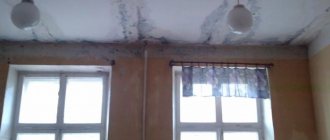Determining the culprit
If the leak occurred due to improper actions or breakdowns in the room above, then the culprit is its rightful owner. If the building is completely non-residential, but it has an owner, then he will be the culprit.
If a retail or other space is leased from the state, then the culprit should be determined after a technical inspection of the entire building, recording damage and conducting an examination.
Important! If the culprit of the flood cannot be determined, a note about this is made in the act.
act on flooding of non-residential premises
In civil legislation, in the article of the Civil Code of the Russian Federation, flooding means harm caused to a person or his property, which must be fully compensated by the person who caused this harm. If you come into the premises and see that you are being drowned, immediately, without removing anything, contact the company servicing the building to record the incident. When inspecting the premises, it is advisable to find the person at fault, as well as the residents and a representative of the utility service. After the inspection, the authorized person must draw up a flooding report, listing all damaged property in it. The document is signed by everyone who took part in the inspection of the premises. If someone refused to sign the document, this must be indicated in the act.
Previous article: Sample apartment flooding report.
Fixing damage
After the flooding has been stopped, the damage must be carefully recorded:
- Measure and indicate the area of damage on the walls, floor, and ceiling.
- Carefully describe the damaged furniture.
- Enter the models of the affected household appliances.
- Make an inventory of the damaged goods.
- Take photos/videos of what happened.
- Indicate what kind of water - hot or cold - flooded the room.
All these details are included in the act and certified by the commission.
Valuation of the management company
The management company assesses the damage based on the drawn up report. The inventory includes the work that needs to be done to repair the damage. It also includes the price of damaged furniture, appliances, and the costs of putting the room in order.
A representative of the management company inspects the affected areas, studies the causes and results of the flood, and records the total amount of damage in his report. This document is then presented to the guilty party for compensation. The victim has the right to involve independent experts in the assessment, and also include lost profits in the amount of payments.
Act - confirming document
The injured party initiates the drawing up of an act. Representatives of the management company, owners of the premises, owners of the area that caused the flood (if identified), engineers or other technical specialists of the service organization should participate in its preparation.
Reference. The document is necessary in order to rely on the Civil Code of the Russian Federation (Article 1064), which states that any material damage caused must be fully compensated by the culprit.
The report must be drawn up as soon as possible, preferably immediately after the accident has been eliminated at the scene after a visual inspection - within 12 hours. If the accident occurred during non-working hours (holidays, weekends), the document must be drawn up no later than three days later. The law does not provide for the form of the act and its compiler.
Employees of the management company can draw up a document only while at the scene of the accident; the victim also has the right to draw up a report.
The act is signed by representatives of the management organization and the owner (in the case of non-residential premises, the tenant also has this right). The report contains a statement of the fact of the accident, a list of persons involved (perpetrators) and an inventory of the damage caused. Often representatives of organizations have samples and forms of such acts, but free drafting of the document is allowed.
The act must indicate:
- Serial number of the document.
- Information about all members of the commission. It is necessary to indicate positions in the management organization. If there are outside witnesses present, recording their passport details is mandatory.
- Time, place, date of document preparation.
- Flood address.
- Causes of the flood (for example, “the commission found that the accident occurred due to a breakdown of the hot water supply system; a pipe with a diameter of 55 millimeters was broken”).
- Details of the culprit (if it was possible to identify it immediately).
- Description of the damage caused.
Here you need to list all the damage and the volume of the affected area. For example, “a non-residential premises (office) with an area of /specify/ suffered the following damage: the ceiling is flooded, there are wet spots, stains. On the walls there is paper wallpaper, filled in (along the perimeter of the walls 4.62X2.5, 2.95X2.5 2.8X2.5 lag behind the walls, there are leaks and peeling). The windows are plastic, not damaged, the floor is linoleum, there is some swelling. The plastic doors - 3 of them - were swollen. Utility room /specify area/: the ceiling is completely filled, there are yellow spots, the walls are whitewashed, there are wet spots on them. The windows were not damaged. Floors: wooden parquet, swollen.” - It is imperative to indicate in the act the cause-and-effect relationship between the accident and the damage caused. For example, “due to a burst hot water pipe, an office located on the first floor, directly below the leak, was flooded.”
- Signatures of all commission members.
- You can also specify:
- Has the premises been renovated/renovated?
- Is there insurance?
- Are there any outstanding payments?
Important! Even if the culprit is not present when the document is drawn up, the act is still drawn up. It is advisable to have it in triplicate.
Act on flooding of non-residential premises
If you agree to compensate for the repair work, no additional problems should arise. However, if the culprit does not intend to compensate for losses, you can initiate legal action by providing the court with all the required documents in the case. According to the law, such a document is drawn up in 2 copies, after which it is signed by the affected person and a technician of the utility organization. Provided that if a representative of the management organization refuses to come for an inspection, while the plaintiff is convinced that he notified the management company correctly, then at a clearly established time it is necessary to begin the inspection without the participation of a representative of the service company. In order for a person to have the right to demand compensation from those responsible for the accident, one must have in hand a document officially confirming the amount of compensation.
If the company does not want to compile it
Often it is the management company that is to blame for the flooding and refuses to draw up a report. In this case, the act is drawn up independently (in the presence of witnesses) and sent to the organization by mail (with notification of receipt).
In this case, a note is made in the act that the organization was informed of the need to be present at the accident site, but did not send its representatives to conduct the examination.
How to calculate the damage in this case?
If the management company refused to attend the scene of the accident, did not inspect the damaged non-residential premises, or violates the deadlines for drawing up the report, then an independent appraiser can be invited. This can be a representative of a company or an individual (but must be a member of a self-regulatory organization of appraisers and have insurance).
The expert works with the accident report in hand and verifying ownership. It is not advisable to carry out restoration work until the damage has been assessed.
After completing the inspection and examination, the appraiser draws up a conclusion indicating the amount of damage. Payments for the services of an independent appraiser can be included in the amount of the claim (if one is created).
Why should you choose an independent appraiser?
The damage assessment carried out by the management company often does not provide a complete picture: the culprits of the accident are not identified, but only the facts are recorded. An independent examination can indicate why it happened later and who is to blame.
If a thorough and attentive approach to the matter is required, excluding the interest of any of the parties, it is better to turn to outside specialists. Advantages of an independent examination:
- Technical specialists of the management company inspecting the accident site may be incompetent in some matters.
- If the management organization is to blame for the accident, it is an interested party.
- The consequences of flooding may become apparent after the initial inspection.
- An independent examination guarantees a thorough study of the problem and the appointment of those responsible after a thorough study of the case.
Owners of non-residential premises in apartment buildings may face not only the problem of flooding. We invite you to familiarize yourself with other useful publications devoted to the proper operation of such real estate, its maintenance and payment of utilities:
- The nuances of maintenance and what does operational management of such property mean?
- Peculiarities of major repairs and who should pay for the one-room payment in an apartment building?
- How to properly organize heating: temperature requirements and tariffs, as well as the nuances of paying for electricity.
- How to draw up an employment contract with a cleaner?
- How to connect the Internet in such a room?
Certificate of flooding of non-residential premises sample
In life, situations arise with flooding of an apartment due to the fault of a neighbor or the unscrupulous fulfillment of its obligations by the management company. In order to be able to recover funds to eliminate the losses incurred, it is necessary to draw up a flood act that proves the flood and describes its consequences. The document will become the basis of the lawsuit. Having noticed a flood in an apartment, you should not immediately panic and immediately eliminate its consequences. The act of flooding the premises is the first and main legal document about the fact of flooding, which requires competent drafting. It establishes the relationship between flooding and the consequences of damage to property. Drawing up the document is the responsibility of the management company. There is no single writing sample, but there are recommended rules for drawing up an act. When the emergency dispatch service receives data about a leak and flooding of the premises, a special commission is created, consisting of: Information about each member is indicated in the document.
Claim
For a peaceful settlement, the victim draws up a document where he indicates what his rights were violated, what he proposes to do to resolve the situation.
Attention! A claim for flooding of non-residential premises is made if there is a need and desire to resolve the problem pre-trial.
Where to send?
The claim is submitted to the culprit by registered mail (the documents sent must be described). The claim can be submitted to the company in person. The document records the incoming number, date, surname and name of the employee who accepted the paper. The submitter also signs the document.
The claim is drawn up in two copies (one for the victim, the other for the culprit). If you can’t bring the papers yourself, you can send them by mail. But be sure to send it by registered mail with acknowledgment of receipt.
How to compose?
Claims must be made only in writing. It can be drawn up either by a lawyer or by the victim himself according to the sample. The document states:
- Full name and other details of the guilty party (address, details, etc.).
- Full name and other data of the injured party (address, details, etc.).
- Place, time of flooding. Inventory of the damaged property (based on the act).
- Description of the victim's expenses.
- Claim for damages.
- Information about the date of flooding, about the property that was damaged at the time of flooding.
- Information about the expenses incurred by the owner in connection with the accident.
- Request for reimbursement of funds spent.
- How does the victim plan to receive funds? For example, “I ask you to compensate for material damage in the amount of /specify/ by transferring to my bank account using the following details /specify/.”
Reference. In case of failure to comply with the requirements, the victim reserves the right to go to court within 20 days from the receipt of the claim by the perpetrator.
If the culprit does not accept the claim or does not want to pay the amount in full, then it is necessary to file a claim in court. The victim (owner of the premises) draws up this statement based on the Code of Civil Procedure of the Russian Federation, Art. 131 and 132. The claim must contain a description of the case, the amount of damage, and demands against the perpetrator.
Where to contact?
The claim is filed at the place of residence of the defendant (in this case, the party responsible for the flooding). However, if in the event of a flood both the defendant and the plaintiff are located in the same house, the claim can be filed at the address of the flooded premises. Both the owner and his authorized representative can apply to the district court.
If it was ignored
The following documents are proof that the injured party took measures for a peaceful settlement, and the culprit ignored them:
- Notice of receipt of the claim (if it was sent by registered mail).
- A copy of the claim indicating the date of receipt, signed by a company employee (if submitted in person).
These documents should be attached to the statement of claim. 20 days after receiving the above-mentioned papers, the victim can go to court (if the claim specified exactly such a period for resolving the dispute). In the event of flooding of non-residential premises - even if great damage has been caused and the consequences of the accident interfere with work - you need to be patient.
Only careful recording of damage, documentation of what happened, inventory, careful assessment and examination will help to recover compensation and achieve restoration work in full.
If you find an error, please select a piece of text and press Ctrl+Enter.
Act on the flooding of an apartment or premises
In the issue of flooding of non-residential premises, or rather compensation for damage from such an action, the main regulatory document is the Civil Code of the Russian Federation. In order for such compensation to become possible, it is necessary to strictly follow the established procedure and procedure. Particular attention should be paid to the documentation and correctness of all acts. This means that the presence of management company employees at the scene of the accident is necessary and mandatory, and it is optimal if this happens at a time when the accident has not yet been localized. But it is permissible if responsible workers visit the accident site as soon as possible after the water is turned off.







